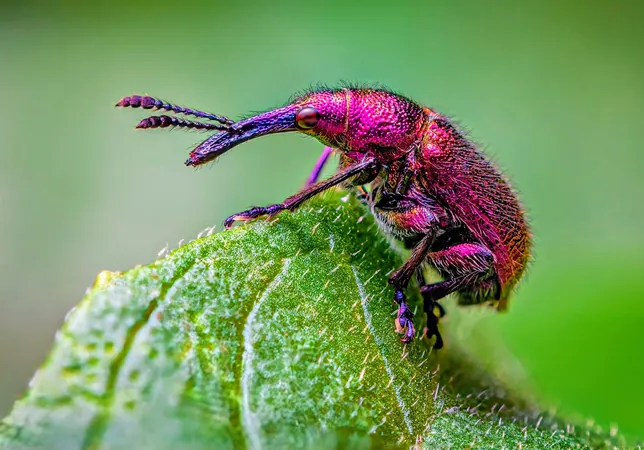
The Silent Crisis: 99% of Insects on Earth Remain Unstudied and at Risk!
2025-04-04
Author: Arjun
The Importance of Insects
Insects, the unsung heroes of our ecosystems, play a crucial role in pollinating crops, recycling nutrients, and serving as a vital food source for myriad species. Yet, alarmingly, scientists have only managed to assess about 1% of the approximately one million known insect species. This translates to roughly 12,100 species evaluated by the International Union for Conservation of Nature (IUCN), with around 20% of those facing extinction threats.
While some attention has been granted to butterflies, dragonflies, and bumblebees, large regions—especially in Africa, Asia, and South America—remain understudied. This leaves a convoluted picture of global insect health, underscoring the urgent need for a comprehensive monitoring strategy.
A Bold Plan to Combat Declining Insect Populations
To counter this worrying trend, researchers at the UK Centre for Ecology & Hydrology (UKCEH) and the Zoological Society of London (ZSL) have proposed an ambitious new methodology. They recognize that climate change, pollution, and habitat destruction are rapidly threatening insect populations, and they aim to act swiftly to prevent irreversible damage.
The new framework will integrate multiple approaches to studying insects, including long-term tracking of diversity and abundance, cross-habitat comparisons, expert insights, and controlled experiments. Dr. Rob Cooke, an ecological modeler with UKCEH, emphasized the pressing need for understanding the decline of insect populations: "It's like piecing together a massive jigsaw puzzle, but we can't afford to wait decades to see the complete picture."
Dr. Charlotte Outhwaite from ZSL’s Institute of Zoology highlighted the critical role of insects, stating, "They pollinate 80% of flowering plants and are essential for 35% of global food production. Yet, they remain undervalued and understudied."
Revolutionizing Insect Monitoring
The proposed monitoring system will analyze time series trends, such as shifts in butterfly populations over ten years, and compare insect diversity across different landscapes, from forests to farmlands. Additionally, researchers will conduct experiments to gauge insect reactions to threats, such as pesticide removal or the elimination of invasive species.
In circumstances lacking adequate data, experts will contribute predictive analyses to appraise potential insect responses to environmental pressures. This multi-faceted approach fosters informed decision-making while acknowledging existing uncertainties, creating a balance that single-method studies cannot achieve.
The Urgency of Action
The framework is part of the Global Insect Threat-Response Synthesis (GLiTRS) project, which aims to model insect responses to significant threats across diverse environments. By amalgamating data from field studies, expert opinions, and experimental results, researchers aspire to depict a clearer picture of insect health on a global scale.
As we face an escalating environmental crisis, the observed decline in insect populations calls for immediate action. With our ecosystems depending on these tiny, often-overlooked creatures, the challenge now lies not in whether we care, but in our commitment to act before it is too late.
Backed by the Natural Environment Research Council (NERC) and engaging esteemed institutions like the Natural History Museum and University College London, this groundbreaking study, which is set to be published in the journal *Science*, serves as a wake-up call. It demonstrates the necessity of adapting scientific methods in response to the compounded challenges posed by a changing planet.
Insects have been silently supporting life on Earth for hundreds of millions of years; now, it's time for us to support them. The clock is ticking—will we heed this urgent call to safeguard our tiny allies before they vanish forever?

 Brasil (PT)
Brasil (PT)
 Canada (EN)
Canada (EN)
 Chile (ES)
Chile (ES)
 Česko (CS)
Česko (CS)
 대한민국 (KO)
대한민국 (KO)
 España (ES)
España (ES)
 France (FR)
France (FR)
 Hong Kong (EN)
Hong Kong (EN)
 Italia (IT)
Italia (IT)
 日本 (JA)
日本 (JA)
 Magyarország (HU)
Magyarország (HU)
 Norge (NO)
Norge (NO)
 Polska (PL)
Polska (PL)
 Schweiz (DE)
Schweiz (DE)
 Singapore (EN)
Singapore (EN)
 Sverige (SV)
Sverige (SV)
 Suomi (FI)
Suomi (FI)
 Türkiye (TR)
Türkiye (TR)
 الإمارات العربية المتحدة (AR)
الإمارات العربية المتحدة (AR)